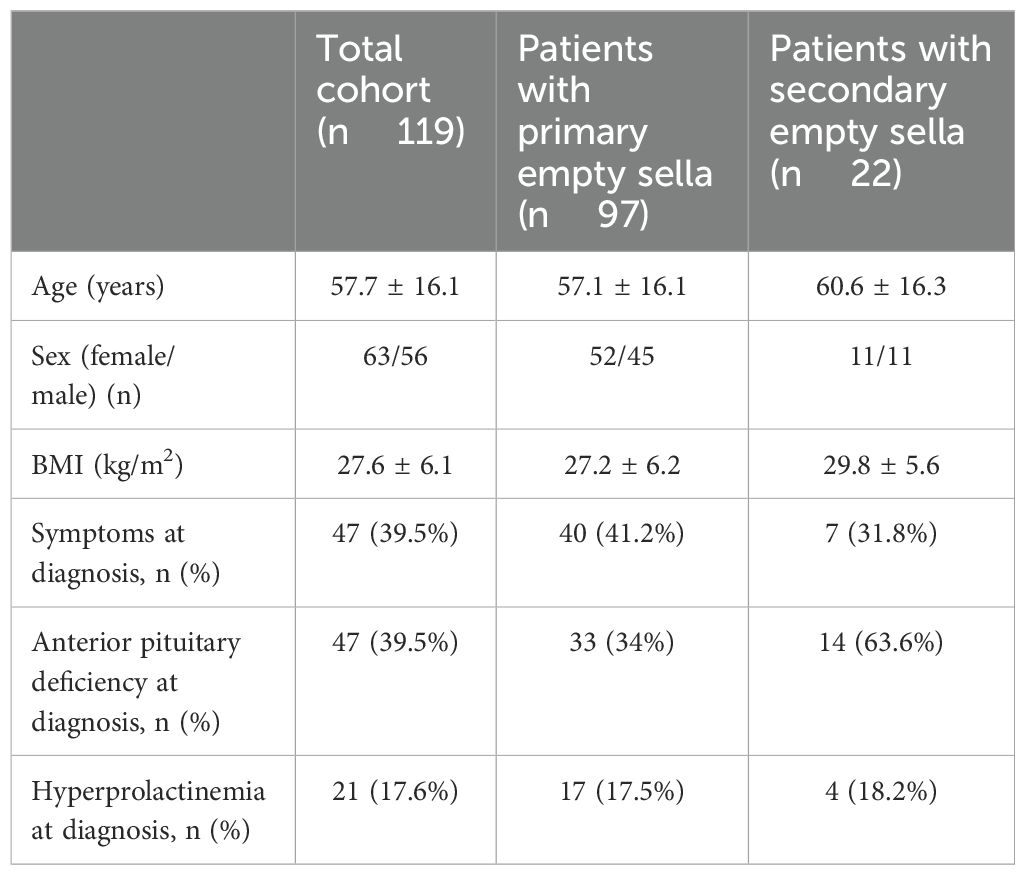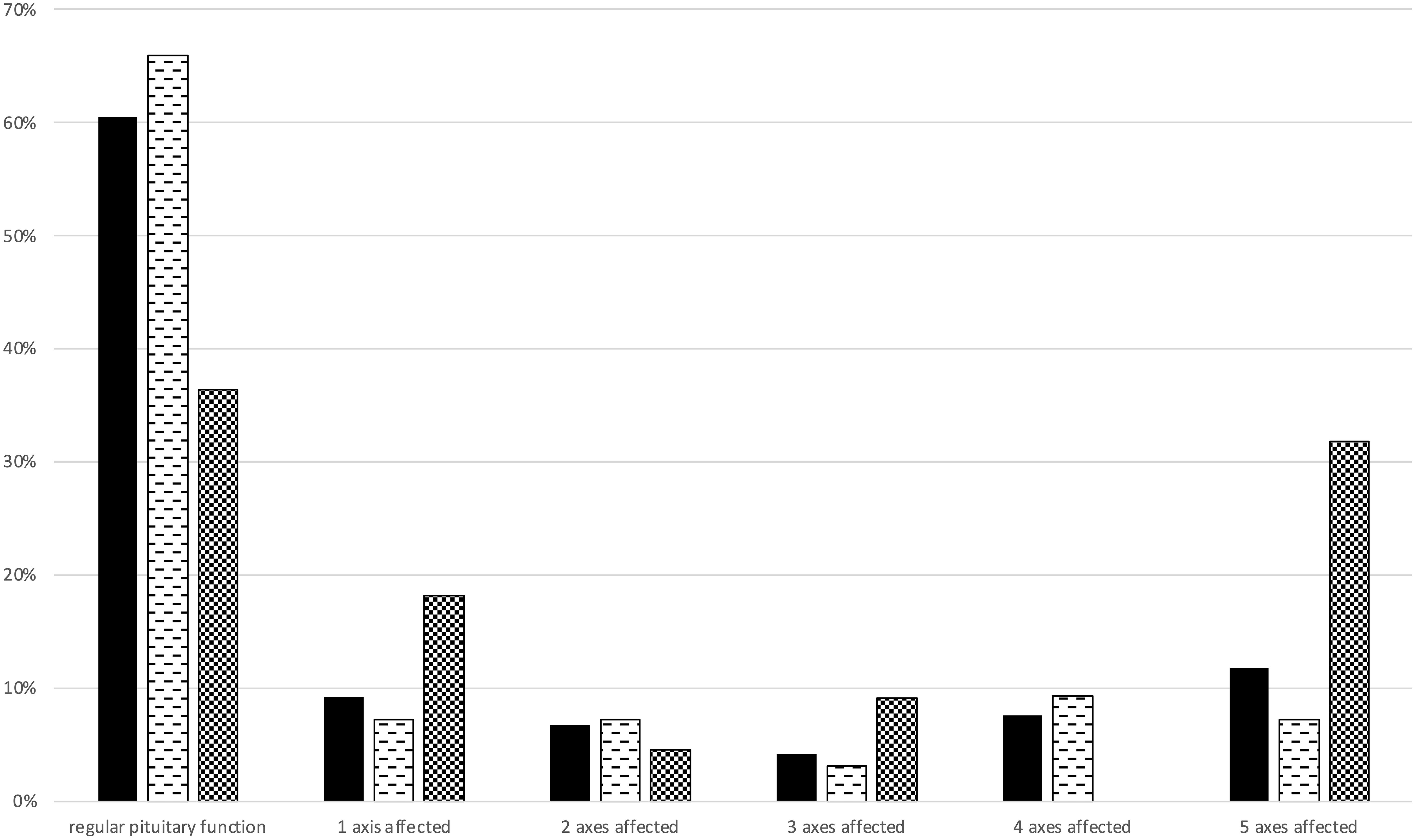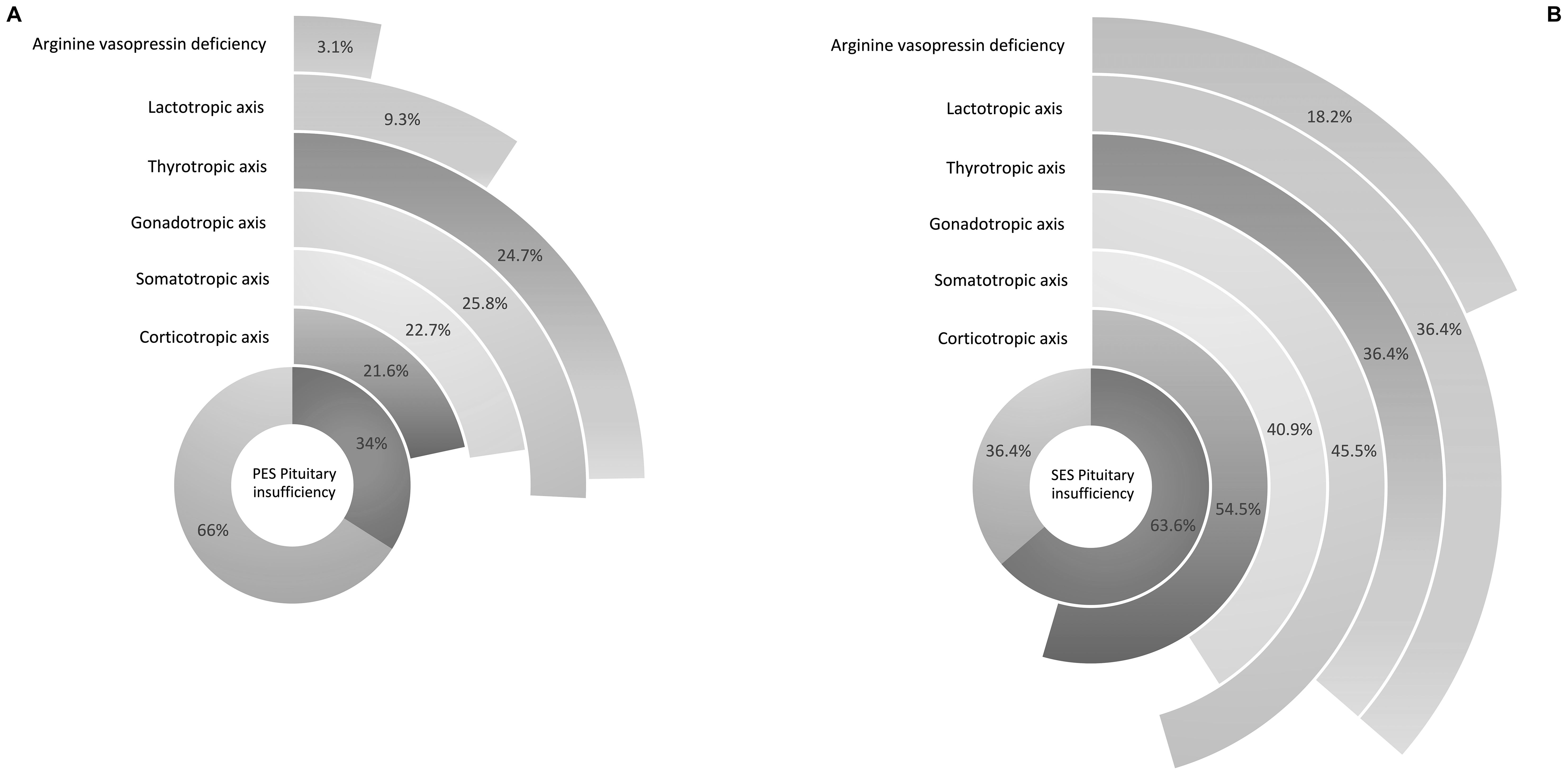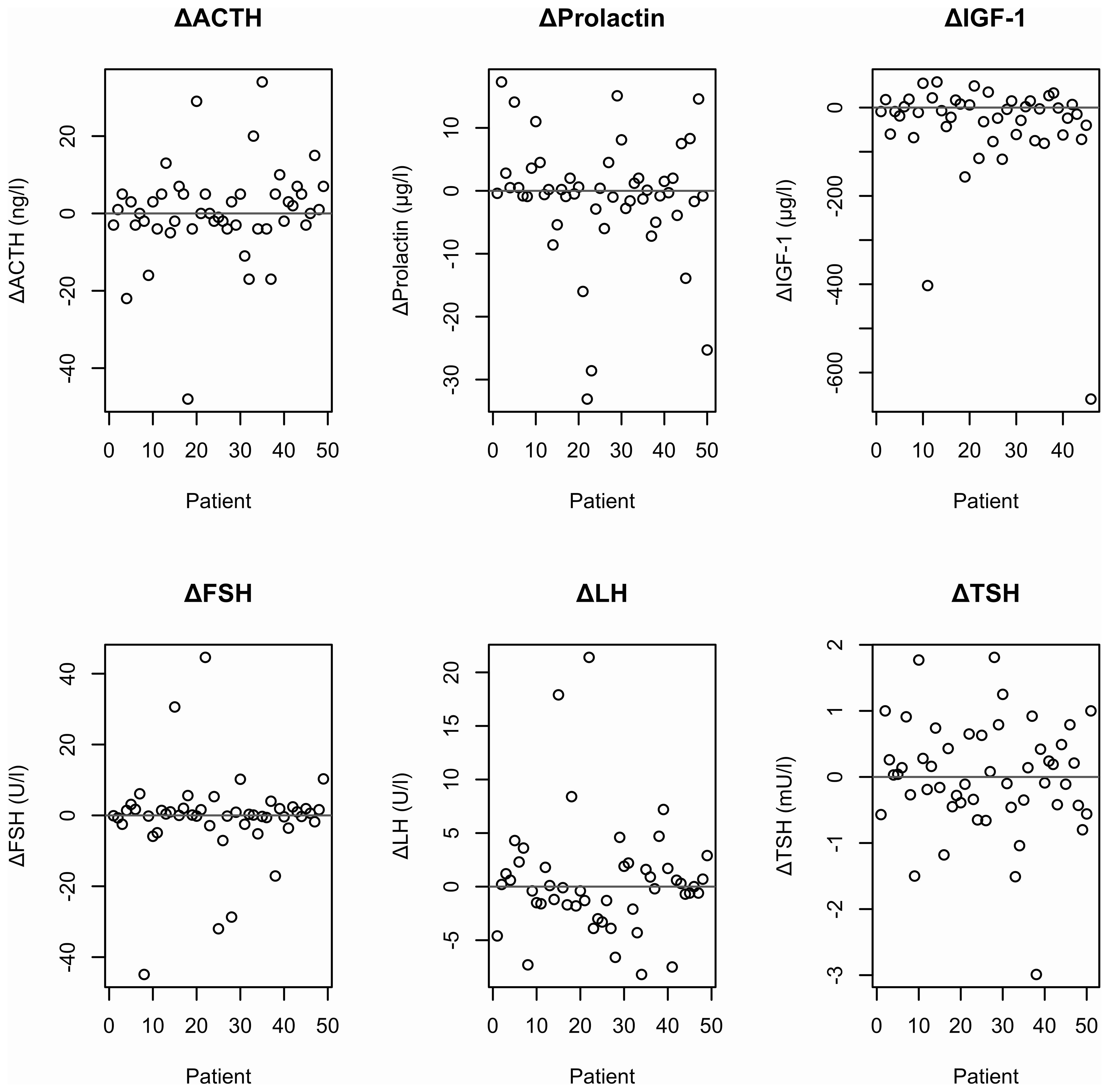- 1Department of Internal Medicine I, Medical University of Innsbruck, Innsbruck, Austria
- 2Department of Radiology, Medical University of Innsbruck, Innsbruck, Austria
- 3Neuroimaging Research Core Facility, Medical University of Innsbruck, Innsbruck, Austria
Background: Due to the increasing availability and sensitivity of neuroradiological imaging, the number of incidental findings of empty sella (ES) is rising, however, the clinical relevance is not clearly defined.
Methods: In this longitudinal, single-center study patients with first-time diagnosed primary or secondary empty sella were analyzed and followed up for five years. Hormone deficiencies were diagnosed by measuring basal pituitary and target organ hormone levels or dynamic stimulation tests.
Results: Overall, 119 patients, 97 with primary (PES) and 22 with secondary empty sella (SES) were included. At baseline, isolated or total pituitary insufficiency was detected in 34% of patients with PES and 63.6% of patients with SES. While hypogonadism was the most common finding in PES affecting 25.8% of patients, adrenal insufficiency was the most frequent finding in SES affecting 54.5% of patients. Only two patients with intact pituitary function at baseline, one with SES and one with PES, were diagnosed with hormone insufficiency during follow-up.
Conclusions: Hormone deficiency is common in empty sella, with males and patients with SES being at highest risk. In patients with intact pituitary function at time of diagnosis, the risk of developing hypopituitarism is low thus not justifying regular follow-up assessments.
Introduction
Easier access, greater availability and increased sensitivity of magnetic resonance imaging have contributed to strongly increasing findings of empty sella. Neuroimaging finding of empty sella might be incidental but might also be associated with symptoms or hormonal disturbances (1–3).
Empty sella is defined as a herniation of the subarachnoid space into the sella turcica (4). Due to the filling of the space with cerebrospinal fluid the pituitary tissue gets compressed at the bottom and consequently the sella turcica appears empty on neuroradiological imaging (4). The etiology of primary empty sella (PES) is not fully understood, but congenital factors such as diaphragm malformation as well as increased cerebrospinal fluid pressure and variations in pituitary gland volume are discussed to contribute to development of empty sella (5). In contrast, secondary empty sella (SES) results from damage to the pituitary gland such as surgical removal of a pituitary tumor, Sheehan syndrome, traumatic brain injury or radiation therapy, respectively (6).
Data on prevalence of primary empty sella diverge widely from 5.5% to 35% (7–9). The clinical presentation of empty sella is very heterogeneous encompassing asymptomatic patients, patients presenting with neurological symptoms and those with partial or complete pituitary deficiency (1, 2). While recent retrospective or observational studies suggest that anterior pituitary deficiency is common in patients with primary empty sella (1–3, 5, 10), evaluation and management of patients with empty sella are still very heterogenous. In a recent work, Ekhzaimy et al. (11) found that only 20% of patients with incidental neuroimaging finding of empty sella were referred to an endocrinologist.
In this work we aimed to assess the frequency and type of endocrine disturbances in patients with primary or secondary empty sella and the course of disease from an endocrine perspective.
Materials and methods
Study population
Patients diagnosed with and treated for empty sella between 2013 and 2023 at the endocrine outpatient clinic at the Department of Internal Medicine I, Medical University Innsbruck were reviewed for participation. Patients with fully available clinical and hormonal data at baseline were enrolled in the study. In some patients only MR reports but not original imaging were available. Analyses included demographic characteristics, symptoms, neuroimaging data and basal hormone levels (prolactin, TSH, fT4, fT3, IGF-1, growth hormone, ACTH, cortisol, FSH, LH, estrogen/testosterone, serum sodium levels) and urinary 24h cortisol levels. GH insufficiency was tested in patients with low or reduced age-adjusted IGF-1 levels or specific symptoms by performing an GHRH arginine test (GHRH: 1 ug/kg body weight, Arginine hydrochloride 0,5 g/kg body weight, maximal dose: 30 g). Stimulated growth hormone (GH) levels lower than 4.1 ng/ml were interpreted as GH deficiency (12).
In patients with specific symptoms of adrenal insufficiency or low basal ACTH and cortisol levels, a standard high dose ACTH stimulation test was performed. Diagnosis of adrenal insufficiency was excluded with peak cortisol levels ≥ 18 ug/dl (500 nmol/l) (13–17).
Hypogonadotropic hypogonadism was diagnosed in male patients with clinical signs, low free testosterone levels and low FSH and LH levels (18). Female hypogonadotropic hypogonadism in women at premenopausal age was diagnosed by amenorrhea for three months or longer, persistently low estrogen levels and low FSH and LH levels. Gonadotropic insufficiency in women at postmenopausal age was diagnosed by low FSH and LH levels (19).
In patients with polydipsia and polyuria, and high or increased serum sodium levels in combination with decreased urine osmolality, a water restriction test followed by nasal insufflation of desmopressin was performed. Doubling of urine osmolality or an increase of urine osmolality by at least 9%/50% to a value > 300 mosmol/kg or > 800 mosmol/kg was interpreted as partial or total arginine desmopressin insufficiency (20–23).
The study protocol was approved by the local ethics committee of the Medical University of Innsbruck (1344/2023).
Statistical analysis
Non-parametric tests were used for group comparisons (Chi-square test, Fisher’s exact test and Mann-Whitney-U test). The analysis was conducted using the software R (version 4.3.3) and SPSS 29. A p-value ≤ 0.05 was considered as statistically significant. Descriptive data are shown as means +/- SD.
Results
119 patients, 63 women and 56 men, with radiologic findings of total or partial empty sella were included in the study.
PES was diagnosed in 97 patients and SES in 22 patients. SES was associated with a history of traumatic brain injury in 1 patient, prolactinoma in 3 patients, non-functioning pituitary adenoma in 16 patients and craniopharyngioma in 2 patients.
Baseline characteristics are shown in Table 1. An empty sella was diagnosed as cause of specific symptoms in 47 (39.5%) patients with higher rates in patients with PES than in SES (PES: n=40 (41.2%); SES: n=7 (31.8%)). Seventy-two patients (60.5%) did not show any symptoms that are considered as typical or at least indicative of hormonal insufficiencies or an empty sella (7). In patients which were classified as being asymptomatic with respect to the empty sella finding migraine workup and visual disturbances were the most common indications for MR imaging.

Table 1. Baseline characteristics of study patients. Nominal variables are denoted in percent (%), continuous data as mean ± standard deviation.
Weakness and fatigue were the most frequently found symptoms affecting 25 (21%) and 23 (19.3%) of patients. Weight loss was reported in 6 (5%) cases and galactorrhea in 4 (3.4%) patients. Muscle pain, amenorrhea, reduced libido, skin lesions, polydipsia and polyuria were reported in two patients each (1.7%) and collapse in one patient (0.84%). No gender-specific differences in symptoms were found.
At baseline total or partial anterior hypopituitarism was diagnosed in 33 (34%) patients with PES and 14 (63.6%) patients with SES. 14 (11.8%) patients suffered from total anterior hypopituitarism, 7 (7.2%) of them belonged to the PES group and 7 (31.8%) to the SES group. The number of affected axes in patients with anterior pituitary deficiency is shown in Figure 1. Arginine vasopressin deficiency was diagnosed in 3 (3.1%) patients with PES and 4 (18.2%) patients with SES. Total pituitary insufficiency was found in 3 (2.5%) patients, all of them belonged to the SES group (13.6%). Hyperprolactinemia was found in 17 (17.5%) patients with PES and 4 (18.2%) with SES.

Figure 1. Anterior pituitary function at baseline. Number of patients (in %) with regular pituitary function or 1, 2, 3, 4 or 5 insufficient axes are shown. 1st column (black) indicates the total cohort, 2nd column (dashed) indicates the primary empty sella cohort, 3rd column (checkered) indicates the secondary empty sella cohort.
Rates and types of hormonal deficiencies are shown in Figure 2.

Figure 2. Hormonal insufficiencies shown in percentages of affected patients with primary empty sella (PES) (A) and secondary empty sella (SES) (B).
In patients with PES, hypogonadism was the most frequent finding affecting 25 patients (25.8%) followed by deficiencies of the thyrotropic axis found in 24 patients (24.7%) and the somatotropic axis affecting 22 (22.7%) patients. Adrenal insufficiency was found in 21 (21.6%) patients with PES.
In contrast, 14 (63.6%) patients with secondary empty sella suffered from pituitary insufficiency. Among patients with SES, adrenal insufficiency was the most frequently found hormonal deficiency affecting 12 (54.5%) patients. This was followed by hypogonadism and insufficiency of the somatotropic axis which was found in 10 (45.5%) and 9 (40.9%) patients. Thyrotropic and lactotropic axis were affected in 8 (36.4%) cases each.
Arginine vasopressin deficiency was diagnosed in 4 (18.2%) SES patients compared to 3 (3.1%) PES patients.
In total, the neuroimaging diagnosis was finally classified as an incidental finding in 64 (53.8%).
Pituitary deficiency was more common in males than in females affecting 29 (51.7%) men and 12 women (19.0%), p < 0.001) at baseline. Age, BMI and preexisting endocrinological disorders were comparable in patients with and without pituitary dysfunction at baseline.
In patients with intact pituitary function at baseline, mean basal hormone levels remained stable over a time period of at least five years indicating stable pituitary function in the majority of patients. Stronger variations were found for FSH and TSH levels only, which might be explained by large physiological and circadian variations of these parameters (Figure 3).

Figure 3. Absolute changes in selected hormone parameters between first presentation and 5-year follow up in patients with intact pituitary function at baseline.
To study the course of pituitary function in patients with empty sella, hormonal status was reassessed at least five years after diagnosis in 52 with fully available follow up data and intact pituitary function at baseline. In the primary empty sella cohort, one 69-year-old woman (BMI 24.3 kg/m2) with intact pituitary function at baseline developed corticotropic, somatotropic and gonadotropic (defined by low FSH and LH levels) deficiency during follow-up. Function of the thyrotropic axis was not assessed in this patient as she had been diagnosed with and treated for primary hypothyroidism before. Additionally, the patient had been diagnosed with primary hyperparathyroidism before. At initial presentation she suffered from fatigue, however, the symptom was not related with any hormonal deficiency at baseline.
In the secondary empty sella cohort, one patient, a 63-year-old obese woman (BMI 33.7 kg/m2) developed deficiencies of the somatotropic and thyreotropic axes during the five-year follow-up. The patient was classified as being asymptomatic at baseline.
Discussion
Empty sella has become a frequent neuroimaging finding that might be an incidental finding without any clinical relevance but which also might be associated with neurological symptoms or hormone deficiencies. In daily practice, evaluation and management of empty sella findings are very heterogenous and often depend on whether patients are referred to endocrinologists or are treated by GPs. In a recent singly-center study in Saudi Arabia, only 1 of 5 patients were referred to endocrinologists (11).
Data on prevalence of hormonal insufficiencies of disease are limited. In a multi-center study by Carosi et al. (5) investigating patients with primary empty sella, hypopituitarism was found in more than 40%, with hypogonadism being the most frequent finding. In this cohort, hormonal deterioration was uncommon during a mean follow-up of 58 months (5). Importantly, pituitary volume did not predict hypopituitarism in patients with primary empty sella in another study (24). Unfortunately, original imaging was not available from all patients in our study. Accordingly, as a limitation of our study, no measurements of pituitary volume are provided.
The aim of our study was to analyze pituitary function in patients with primary or secondary empty sella and to investigate the natural course of pituitary function over a time period of five years. Importantly, we found that 39.5% of patients with empty sella display partial or total pituitary insufficiency. These results are in line with data from others (1, 3, 5–7, 25–27) including the multicenter study by Carosi et al., who reported that 40% of patients with primary empty sella (including patients with a history of traumatic brain injury) suffered from hypopituitarism (5).
In our study, risk of pituitary insufficiency was markedly higher in patients with secondary empty sella than in those with primary empty sella.
Prevalence of arginine-vasopressin deficiency was low in patients with primary empty sella but affected 4 of 22 patients with secondary empty sella in our study. In total, number of affected axes was distributed evenly. Total anterior hypopituitarism was present in 11.8% of patients. In 76.6% of patients with pituitary insufficiency, at least two hormonal axes were affected.
In patients with primary empty sella and overt anterior pituitary deficiency, hypogonadism was the most frequent finding. Thyrotropic, somatotropic and corticotropic axes were also affected in 21.6% - 24.7% of patients, respectively. Very importantly, in patients with secondary empty sella, adrenal insufficiency was detected in more than 50% of affected patients. Rates of hyperprolactinemia were comparable in patients with primary and secondary empty sella syndrome and was uncommonly associated with presence of galactorrhea.
While the exact pathophysiological mechanism remains to be determined, we hypothesize that mild hyperprolactinemia found in these patients indicate or result from pituitary stalk compression due to filling of the space with cerebrospinal fluid.
These results underline the urgent need of an initial endocrinological assessment in all patients diagnosed with empty sella. Very importantly, prevalence of potentially life-threatening adrenal insufficiency is high, especially in patients with secondary empty sella suggesting the importance of clinical and laboratory evaluation in patients with unspecific symptoms such as fatigue or weakness also.
While empty sella was more prevalent in women (3, 7, 28), pituitary deficiency was more frequent in males than in females in our study suggesting sex-specific differences in etiology and pathophysiology of empty sella syndrome.
Little is known about the natural course of pituitary function in patients with empty sella (5, 29). In our study we found stable basal hormone parameters in the majority of patients. Variations in TSH and FSH levels might rather be explained by natural fluctuations than by changes in pituitary function in patients with empty sella.
Importantly, only two patients, one with primary empty sella and one with secondary empty sella developed pituitary insufficiency over the follow-up period of at least five years, suggesting that aggravation of pituitary function in patients with intact function at diagnosis is rare.
In conclusion, our study shows that pituitary deficiency is common among patients with empty sella and especially frequently found in patients with secondary empty sella. This underlines the urgent need of clinical and endocrinological assessments at diagnosis. Adrenal insufficiency is common, endocrine examination should also include dynamic testing in symptomatic patients. Furthermore, our data suggest against regular follow-up investigations in asymptomatic patients with intact pituitary function at baseline.
Data availability statement
The original contributions presented in the study are included in the article/Supplementary Material. Further inquiries can be directed to the corresponding author.
Ethics statement
The studies involving humans were approved by Ethics Committee of the Medical University of Innsbruck. The studies were conducted in accordance with the local legislation and institutional requirements. For retrospective analysis written consent is not necessary (decision by the local ethics committee).
Author contributions
LS: Data curation, Writing – review & editing, Writing – original draft, Investigation, Formal Analysis. EG: Resources, Writing – original draft, Writing – review & editing. SK: Resources, Formal Analysis, Validation, Project administration, Writing – original draft, Supervision, Writing – review & editing, Methodology, Conceptualization.
Funding
The author(s) declare that no financial support was received for the research and/or publication of this article.
Conflict of interest
The authors declare that the research was conducted in the absence of any commercial or financial relationships that could be construed as a potential conflict of interest.
Generative AI statement
The author(s) declare that no Generative AI was used in the creation of this manuscript.
Publisher’s note
All claims expressed in this article are solely those of the authors and do not necessarily represent those of their affiliated organizations, or those of the publisher, the editors and the reviewers. Any product that may be evaluated in this article, or claim that may be made by its manufacturer, is not guaranteed or endorsed by the publisher.
References
1. Guitelman M, Garcia Basavilbaso N, Vitale M, Chervin A, Katz D, Miragaya K, et al. Primary empty sella (PES): a review of 175 cases. Pituitary. (2013) 16:270–4. doi: 10.1007/s11102-012-0416-6
2. Lundholm MD and Yogi-Morren D. A comprehensive review of empty sella and empty sella syndrome. Endocr Pract. (2024) 30:497–502. doi: 10.1016/j.eprac.2024.03.004
3. De Marinis L, Bonadonna S, Bianchi A, Maira G, and Giustina A. Primary empty sella. J Clin Endocrinol Metab. (2005) 90:5471–7. doi: 10.1210/jc.2005-0288
4. Bergland RM, Ray BS, and Torack RM. Anatomical variations in the pituitary gland and adjacent structures in 225 human autopsy cases. J Neurosurg. (1968) 28:93–9. doi: 10.3171/jns.1968.28.2.0093
5. Carosi G, Brunetti A, Mangone A, Baldelli R, Tresoldi A, Del Sindaco G, et al. A multicenter cohort study in patients with primary empty sella: hormonal and neuroradiological features over a long follow-up. Front Endocrinol (Lausanne). (2022) 13:925378. doi: 10.3389/fendo.2022.925378
6. Auer MK, Stieg MR, Crispin A, Sievers C, Stalla GK, and Kopczak A. Primary empty sella syndrome and the prevalence of hormonal dysregulation. Dtsch Arztebl Int. (2018) 115:99–105. doi: 10.3238/arztebl.2018.0099
7. Chiloiro S, Giampietro A, Bianchi A, Tartaglione T, Capobianco A, Anile C, et al. Diagnosis of endocrine disease: Primary empty sella: a comprehensive review. Eur J Endocrinol. (2017) 177:275–85. doi: 10.1530/EJE-17-0505
8. Kaufman B. The “Empty” Sella turcica - A manifestation of the intrasellar subarachnoid space. Radiology. (1968) 90:931–41. doi: 10.1148/90.5.931
9. Busch W. Die Morphologie der Sella turcica und ihre Beziehungen zur Hypophyse. Virchows Arch Pathol Anat Physiol Klin Med. (1951) 320:437–58. doi: 10.1007/BF00957474
10. Ghatnatti V, Sarma D, and Saikia U. Empty sella syndrome - beyond being an incidental finding. Indian J Endocrinol Metab. (2012) 16:321–3. doi: 10.4103/2230-8210.104075
11. Ekhzaimy AA, Mujammami M, Tharkar S, Alansary MA, and Al Otaibi D. Clinical presentation, evaluation and case management of primary empty sella syndrome: a retrospective analysis of 10-year single-center patient data. BMC Endocr Disord. (2020) 20:142. doi: 10.1186/s12902-020-00621-5
12. Biller BM, Samuels MH, Zagar A, Cook DM, Arafah BM, Bonert V, et al. Sensitivity and specificity of six tests for the diagnosis of adult GH deficiency. J Clin Endocrinol Metab. (2002) 87:2067–79. doi: 10.1210/jcem.87.5.8509
13. Javorsky BR, Raff H, Carroll TB, Algeciras-Schimnich A, Singh RJ, Colón-Franco JM, et al. New Cutoffs for the Biochemical Diagnosis of Adrenal Insufficiency after ACTH Stimulation using Specific Cortisol Assays. J Endocr Soc. (2021) 5:bvab022. doi: 10.1210/jendso/bvab022
14. Ramadoss V, Lazarus K, Prevost AT, Tan T, Meeran K, and Choudhury S. Improving the interpretation of afternoon cortisol levels and SSTs to prevent misdiagnosis of adrenal insufficiency. J Endocr Soc. (2021) 5:bvab147. doi: 10.1210/jendso/bvab147
15. Husni H, Abusamaan MS, Dinparastisaleh R, Sokoll L, Salvatori R, and Hamrahian AH. Cortisol values during the standard-dose cosyntropin stimulation test: Personal experience with Elecsys cortisol II assay. Front Endocrinol (Lausanne). (2022) 13:978238. doi: 10.3389/fendo.2022.978238
16. Mahzari M, AlSohaim A, Al Mulla A, AlAssaf A, Al Amri K, Hussain SD, et al. Variations in cortisol response in patients with known and suspected adrenal insufficiency. Med (Baltimore). (2022) 101:e32557. doi: 10.1097/MD.0000000000032557
17. Zha L, Li J, Krishnan SM, Brennan MR, Zhang YV, Povse P, et al. New diagnostic cutoffs for adrenal insufficiency after cosyntropin stimulation using abbott architect cortisol immunoassay. Endocr Pract. (2022) 28:684–9. doi: 10.1016/j.eprac.2022.04.003
18. Bhasin S, Brito JP, Cunningham GR, Hayes FJ, Hodis HN, Matsumoto AM, et al. Testosterone therapy in men with hypogonadism: an endocrine society clinical practice guideline. J Clin Endocrinol Metab. (2018) 103:1715–44. doi: 10.1210/jc.2018-00229
19. Jayasena CN, Devine K, Barber K, Comninos AN, Conway GS, Crown A, et al. Society for endocrinology guideline for understanding, diagnosing and treating female hypogonadism. Clin Endocrinol. (2024) 101:409–42. doi: 10.1111/cen.15097
20. Miller M, Dalakos T, Moses AM, Fellerman H, and Streeten DH. Recognition of partial defects in antidiuretic hormone secretion. Ann Intern Med. (1970) 73:721–9. doi: 10.7326/0003-4819-73-5-721
21. Atila C, Refardt J, and Christ-Crain M. Arginine vasopressin deficiency: diagnosis, management and the relevance of oxytocin deficiency. Nat Rev Endocrinol. (2024) 20:487–500. doi: 10.1038/s41574-024-00985-x
22. Tomkins M, Lawless S, Martin-Grace J, Sherlock M, and Thompson CJ. Diagnosis and management of central diabetes insipidus in adults. J Clin Endocrinol Metab. (2022) 107:2701–15. doi: 10.1210/clinem/dgac381
23. Zerbe RL and Robertson GL. A comparison of plasma vasopressin measurements with a standard indirect test in the differential diagnosis of polyuria. N Engl J Med. (1981) 305:1539–46. doi: 10.1056/NEJM198112243052601
24. Akkus G, Sözütok S, Odabaş F, Onan B, Evran M, Karagun B, et al. Pituitary volume in patients with primary empty sella and clinical relevance to pituitary hormone secretion: A retrospective single center study. Curr Med Imaging. (2021) 17:1018–24. doi: 10.2174/1573405617666210525111218
25. Cannavò S, Curtò L, Venturino M, Squadrito S, Almoto B, Narbone MC, et al. Abnormalities of hypothalamic-pituitary-thyroid axis in patients with primary empty sella. J Endocrinol Invest. (2002) 25:236–9. doi: 10.1007/BF03343996
26. Zuhur S, Kuzu I, Uysal E, and Altuntas Y. Anterior pituitary hormone deficiency in subjects with total and partial primary empty sella: do all cases need endocrinological evaluation? Turk Neurosurg. (2014) 24:374–9. doi: 10.5137/1019-5149.JTN.8671-13.0
27. Colao A, Cotta OR, Ferone D, Torre ML, Ferraù F, Di Somma C, et al. Role of pituitary dysfunction on cardiovascular risk in primary empty sella patients. Clin Endocrinol (Oxf). (2013) 79:211–6. doi: 10.1111/cen.12122
28. Foresti M, Guidali A, and Susanna P. Primary empty sella. Incidence in 500 asymptomatic subjects examined with magnetic resonance. Radiol Med. (1991) 81:803–7.
Keywords: primary empty sella, hypopituitarism, clinical course, endocrine assessments, secondary empty sella
Citation: Steckel L, Gizewski ER and Kaser S (2025) Pituitary function in patients with primary and secondary empty sella. Front. Endocrinol. 16:1632824. doi: 10.3389/fendo.2025.1632824
Received: 21 May 2025; Accepted: 30 June 2025;
Published: 16 July 2025.
Edited by:
Hermann Lothar Mueller, Klinikum Oldenburg, GermanyReviewed by:
Agnieszka Bogusz-Wójcik, Children’s Memorial Health Institute (IPCZD), PolandUte Bartels, Heidelberg University, Germany
Copyright © 2025 Steckel, Gizewski and Kaser. This is an open-access article distributed under the terms of the Creative Commons Attribution License (CC BY). The use, distribution or reproduction in other forums is permitted, provided the original author(s) and the copyright owner(s) are credited and that the original publication in this journal is cited, in accordance with accepted academic practice. No use, distribution or reproduction is permitted which does not comply with these terms.
*Correspondence: Susanne Kaser, U3VzYW5uZS5rYXNlckBpLW1lZC5hYy5hdA==
 Lucas Steckel1
Lucas Steckel1 Elke R. Gizewski
Elke R. Gizewski Susanne Kaser
Susanne Kaser